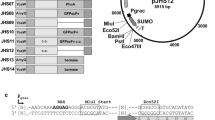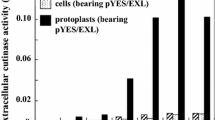Abstract
Both the secretion and the cell surface display of Bacillus subtilis lipase A (Lip A) in Saccharomyces cerevisiae was investigated using different domains of the cell wall protein Pir4 as translational fusion partners. LipA gene minus its leader peptide was fused inframe in two places of PIR4 to achieve cell wall targeting, or substituting most of the PIR4 sequence, after the signal peptide and the Kex2 processed subunit I of Pir4 to achieve secretion to the growth medium. Expression of the recombinant fusion proteins was investigated in a standard and a glycosylation-deficient strain of S. cerevisiae, grown in selective or rich medium. Fusion proteins intended to be retained at the cell wall were secreted to the growth medium, most likely as result of the degradation of the Pir4 moiety containing the cell wall retention domain, giving low levels of lipase activity. However, the fusion intended for secretion was efficiently secreted in a percentage of close to 90% and remained stable even in rich medium at high cell density cultures, yielding values of over 400 IU of lipase activity per milliliter of cell supernatant. This is, to our knowledge, the first report of the efficient production, as a secreted protein, of lipase A of B. subtilis in baker’s yeast.




Similar content being viewed by others
References
Ahn JO, Jang HW, Lee HW, Choi ES, Haam SJ, Oh TK, Jung JK (2003) Overexpression of thermoalkalophilic lipase from Bacillus stearothermophilus L1 in Saccharomyces cerevisiae. J Microbiol Biotechnol 13:451–456
Ahn JO, Choi ES, Lee HW, Hwang SH, Kim CS, Jang HW, Haam SJ, Jung JK (2004) Enhanced secretion of Bacillus stearothermophilus L1 lipase in Saccharomyces cerevisiae by translational fusion to cellulose-binding domain. Appl Microbiol Biotechnol 64:833–839
Anderson JA (1939) The use of tributyrin agar in dairy bacteriology. Ber 3 Int Mikrobiol Kongress 3:726–728
Andrés I, Zueco J, Parascandola P (2003) Immobilization of Saccharomyces cerevisiae cells to protein G-Sepharose by cell wall engineering. J Mol Microbiol Biotechnol 5:161–166
Andrés I, Gallardo O, Parascandola P, Pastor FIJ, Zueco J (2005) Use of cell wall protein Pir4 as a fusion partner for the expresión of Bacillus sp. BP-7 xylanase A in Saccharomyces cerevisiae. Biotech Bioeng 89:690–697
Andrés I, Rodríguez-Díaz J, Buesa J, Zueco J (2006) Yeast expresión of the VP8* fragment of the rotavirus spike protein and its use as immunogen in mice. Biotechnol Bioeng 93:89–98
Arpigny JL, Jaeger KE (1999) Bacterial lipolytic enzymes: classification and properties. Biochem J 1343:177–183
Borch J, Jensen B (1997) Effect and functionality of lipases in dough and bread. DANISCO Ingredients, Denmark. VII Meeting on Industrial Applications of Enzymes, Barcelona. Spain
Bornscheuer UT (2002) Microbial carboxyl esterases: classification, properties and application in biocatalysis. FEMS Microbiol Rev 26:73–81
Burnette WN (1981) Western blotting: electrophoretic transfer of proteins from sodium dodecyl-sulfate-polyacrylamide gels to unmodified nitrocellulose and radiographic detection with antibody and radioiodinated protein A. Anal Biochem 112:195–203
Dartois V, Baulard A, Schanck K, Colson C (1992) Cloning, nucleotide sequence and expression in Escherichia coli of a lipase gene from Bacillus subtilis 168. Biochim Biophys Acta 1131:253–260
Dartois V, Coppée JY, Colson C, Baulard A (1994) Genetic analysis and overexpression of lipolytic activity in Bacillus subtilis. Appl Environ Microbiol 60:1670–1673
Detry J, Rosenbaum T, Lütz S, Hahn D, Jaeger KE, Müller M, Eggert T (2006) Biocatalytic production of enantiopure cyclohexane-trans-1,2-diol using extracellular lipases from Bacillus subtilis. Appl Microbiol Biotechnol 72:1107–1116
Diaz P, Prim N, Pastor FIJ (1999) Direct fluorescence-based lipase activity assay. BioTechniques 27:696–700
Gietz RD, Sugino A (1988) New yeast—Escherichia coli shuttle vector constructed with in vitro mutagenized yeast genes lacking six-base pair restriction sites. Gene 74:527–534
Gupta R, Gupta N, Rathi P (2004) Bacterial lipases: an overview of production, purification and biochemical properties. Appl Microbiol Biotechnol 64:763–781
Hernandez LM, Ballou L, Alvarado E, Gillece-Castro BL, Burlingame AL, Ballou CE (1989) A new Saccharomyces cerevisiae mnn mutant N-linked oligosaccharide structure. J Biol Chem 246:11846–11856
Ito H, Fukuda Y, Murata K, Kimura A (1983) Transformation of intact yeast cells treated with alkali cations. J Bacteriol 153:163–168
Jaeger KE, Reetz MT (1998) Microbial lipases form versatile tools for biotechnology. Trends Biochem Biotech 16:396–403
Jaeger KE, Eggert T (2002) Lipases for biotechnology. Curr Opin Biotechnol 13:390–397
Jaeger KE, Dijkstra BW, Reetz MT (1999) Bacterial biocatalists: molecular biology, three-dimensional structures, and biotechnological applications of lipases. Annu Rev Microbiol 53:315–351
Laemmli UK (1970) Cleavage of structural proteins during the head assembly of bacteriophage T4. Nature 227:680–685
Lesuisse E, Schank K, Colson C (1993) Purification and primary characterization of the extracellular lipase of Bacillus subtilis 168, an extreme basic pH tolerant enzyme. Eur J Biochem 216:155–160
Monfort A, Blasco A, Sanz P, Prieto JA (1999) Expression of LIP1 and LIP2 genes from Geotrichum species in baker’s yeast strains and their application to the bread-making. J Agric Food Chem 47:803–808
Moukadiri I, Zueco J (2001) Evidence for the attachment of Hsp150/Pir2 to the cell wall of Saccharomyces cerevisiae through disulfide bridges. FEMS Yeast Res 1:241–245
Moukadiri I, Jaafar L, Zueco J (1999) Identification of two mannoproteins released from cell walls of a Saccharomyces cerevisiae mnn1 mnn9 double mutant by reducing agents. J Bacteriol 181:4741–4745
Ollis DL, Cheah E, Cygler M, Dijkstra B, Frolow F, Franken SM, Harel M, Remington SJ, Silman I, Schrag J et al (1992) The alpha/beta hydrolase fold. Protein Eng 5:197–211
Poutanen K (1997) Enzymes: an important tool in the improvement of the quality of cereal foods. Trends Food Sci Technol 8:300–306
Prim N, Blanco A, Martínez J, Pastor FIJ, Diaz P (2000) estA, a gene coding for a cell-bound esterase from Paenibacillus sp. BP-23, is a new member of the bacterial subclass of type B carboxylesterases. Res Microbiol 151:303–312
Prim N, Pastor FIJ, Diaz P (2001) Cloning and characterization of a bacterial cell-bound type B carboxylesterase from Bacillus sp. BP-7. Curr Microbiol 42:237–240
Rajakumara E, Acharya P, Ahmad S, Sankaranaryanan R, Rao NM (2008) Structural basis for the remarkable stability of Bacillus subtilis lipase A (Lip A) at low pH. Biochem Biophys Acta 1784:302–311
Ruiz C, Pastor FIJ, Díaz P (2003) Isolation and characterization of Bacillus sp. BP-6 LipA, a ubiquitous lipase among mesophilic Bacillus species. Lett Appl Microbiol 37:354–359
Sambrook J, Fritsch EF, Maniatis T (1989) Molecular cloning: a laboratory manual, 2nd edn. Cold Spring Harbor Laboratory, Cold Spring Harbor
Sánchez M, Prim M, Rández-Gil F, Pastor FIJ, Díaz P (2002) Engineering of baker’s yeasts, E.coli and Bacillus hosts for the production of Bacillus subtilis Lipase A. Biotech Bioeng 78:339–345
Si QJ (1997) Synergistic effect of enzymes for bread-baking. Cereal Foods World 42:802–807
Towbin H, Staehelin T, Gordon J (1979) Electrophoretic transfer of proteins from polyacrylamide gels to nitrocellulose sheets: procedure and some applications. Proc Natl Acad Sci U S A 76:4350–4354
Van Pouderoyen G, Eggert T, Jaeger KE, Dijkstra BW (2001) The crystal structure of Bacillus subtilis: lipase: a minimal α/β hydrolase fold enzyme. J Mol Biol 309:215–226
Ying M, Chen G (2007) Study on the production of biodiesel by magnetic cell biocatalyst based on lipase-producing Bacillus subtilis. App Biochem Biotechnol 137–140:793–803
Acknowledgements
This work was supported by grant ISCIII2006-PI0731 from the Ministerio de Sanidad/Instituto de la Salud Carlos III (Spain). María Mormeneo and Cristina Bofill were recipient of predoctoral grants from the Programa Nacional de Formación de Profesorado Universitario del Ministerio de Educación y Ciencia. Isabel Andrés was the recipient of a predoctoral grant from the Generalitat Valenciana.
Author information
Authors and Affiliations
Corresponding author
Rights and permissions
About this article
Cite this article
Mormeneo, M., Andrés, I., Bofill, C. et al. Efficient secretion of Bacillus subtilis lipase A in Saccharomyces cerevisiae by translational fusion to the Pir4 cell wall protein. Appl Microbiol Biotechnol 80, 437–445 (2008). https://doi.org/10.1007/s00253-008-1549-4
Received:
Revised:
Accepted:
Published:
Issue Date:
DOI: https://doi.org/10.1007/s00253-008-1549-4




